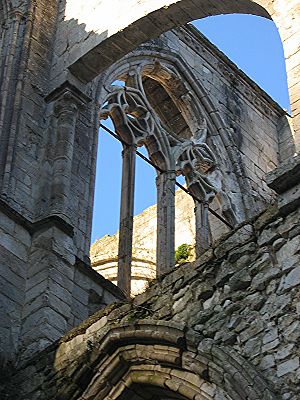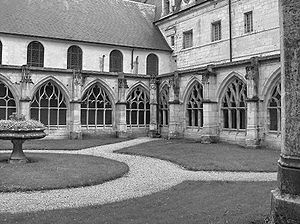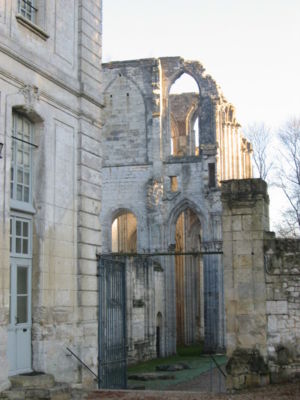
Fontenelle Abbey
Encyclopedia


Saint-Wandrille-Rançon
Saint-Wandrille-Rançon is a commune in the Seine-Maritime department in the Haute-Normandie region in north west France.-Geography:A village of farming and forestry situated by the banks of the Seine, some south of Rouen at the junction of the D22, D33 and the D982 roads. Until 1960, the Pont de...
near Caudebec-en-Caux
Caudebec-en-Caux
Caudebec-en-Caux is a commune in the Seine-Maritime department in the Haute-Normandie region in northern France.-Geography:Caudebec-en-Caux is located W.N.W. of Rouen, on the right bank of the River Seine. The tidal bore in the estuary of the Seine which is known as the mascaret in French, but...
in Seine-Maritime
Seine-Maritime
Seine-Maritime is a French department in the Haute-Normandie region in northern France. It is situated on the northern coast of France, at the mouth of the Seine, and includes the cities of Rouen and Le Havre...
, Normandy
Normandy
Normandy is a geographical region corresponding to the former Duchy of Normandy. It is in France.The continental territory covers 30,627 km² and forms the preponderant part of Normandy and roughly 5% of the territory of France. It is divided for administrative purposes into two régions:...
, France
France
The French Republic , The French Republic , The French Republic , (commonly known as France , is a unitary semi-presidential republic in Western Europe with several overseas territories and islands located on other continents and in the Indian, Pacific, and Atlantic oceans. Metropolitan France...
.
First foundation
It was founded by WandregiselWandregisel
Saint Wandregisel was a Frankish courtier, monk, and abbot. The son of Waltchis, himself a kinsman of Pepin of Landen, he was born near Verdun in the region then known as Austrasia....
or Saint Wandrille (d. 668) on land obtained through the influence of Wandregisel's friend Saint Ouen
Ouen
Audoin, Audoen or Ouen, and Dado to his contemporaries, , was a Frankish bishop, courtier, chronicler, and Catholic saint....
, Archbishop of Rouen
Archbishop of Rouen
The Roman Catholic Archdiocese of Rouen is an Archdiocese of the Latin Rite of the Roman Catholic Church in France. As one of the fifteen Archbishops of France, the ecclesiastical province of the archdiocese comprises the majority of Normandy....
. Saint Wandrille held a high position at the court of his king, Dagobert I
Dagobert I
Dagobert I was the king of Austrasia , king of all the Franks , and king of Neustria and Burgundy . He was the last Merovingian dynast to wield any real royal power...
, but wishing to devote his life to God, he retired to the abbey of Montfaucon
Montfaucon
-Places:*In Switzerland**Montfaucon, Switzerland, in the canton of Jura*In France** Montfaucon, Aisne, in the Aisne département** Montfaucon, Doubs, in the du Doubs département** Montfaucon, Gard, in the Gard département...
, in Champagne
Champagne (province)
The Champagne wine region is a historic province within the Champagne administrative province in the northeast of France. The area is best known for the production of the sparkling white wine that bears the region's name...
, in 629. Later on he went to Bobbio Abbey
Bobbio Abbey
Bobbio Abbey is a monastery founded by Irish Saint Columbanus in 614, around which later grew up the town of Bobbio, in the province of Piacenza, Emilia-Romagna, Italy. It is dedicated to Saint Columbanus...
and then to Romainmôtier, where he remained ten years. In 648 he returned to Normandy and established the monastery of Fontenelle, using the Rule of Saint Columbanus
Columbanus
Columbanus was an Irish missionary notable for founding a number of monasteries on the European continent from around 590 in the Frankish and Lombard kingdoms, most notably Luxeuil and Bobbio , and stands as an exemplar of Irish missionary activity in early medieval Europe.He spread among the...
, which he had known at Bobbio; the deed of gift of the land is dated 1 March 649.
Architecture
He first built a Carolingian styleCarolingian architecture
Carolingian architecture is the style of north European Pre-Romanesque architecture belonging to the period of the Carolingian Renaissance of the late 8th and 9th centuries, when the Carolingian family dominated west European politics...
basilica
Basilica
The Latin word basilica , was originally used to describe a Roman public building, usually located in the forum of a Roman town. Public basilicas began to appear in Hellenistic cities in the 2nd century BC.The term was also applied to buildings used for religious purposes...
dedicated to Saint Peter
Saint Peter
Saint Peter or Simon Peter was an early Christian leader, who is featured prominently in the New Testament Gospels and the Acts of the Apostles. The son of John or of Jonah and from the village of Bethsaida in the province of Galilee, his brother Andrew was also an apostle...
, nearly three hundred feet long, which was consecrated by Saint Ouen in 657. (This church was destroyed by fire in 756 and rebuilt by abbot Ansegisus (823–33), who added a narthex
Narthex
The narthex of a church is the entrance or lobby area, located at the end of the nave, at the far end from the church's main altar. Traditionally the narthex was a part of the church building, but was not considered part of the church proper...
and tower).
The monastery was extremely successful at first, and produced many saints and prelates. In 740 however there began a series of lay abbot
Lay abbot
Lay abbot is a name used to designate a layman on whom a king or someone in authority bestowed an abbey as a reward for services rendered; he had charge of the estate belonging to it, and was entitled to part of the income.This custom existed principally in the Frankish Empire from the eighth...
s, under whom the monastery declined. Saint Ansegisus
Ansegisus
Saint Ansegisus was a monastic reformer of the Franks.Beginning his career as a monk at Fontenelle Abbey, he was soon given the task of reforming monasteries at St. Sixtus near Reims and St. Memius in the diocese of Châlons-sur-Marne, in which he was successful...
, the reformer of Luxeuil Abbey
Luxeuil Abbey
Luxeuil Abbey was one of the oldest and best-known monasteries in Burgundy, located in the "département" of Haute-Saône in Franche-Comté, France.-Columbanus:...
, was appointed in 823 abbot of Fontenelle, which he also reformed.
The abbey soon became a target for Viking
Viking
The term Viking is customarily used to refer to the Norse explorers, warriors, merchants, and pirates who raided, traded, explored and settled in wide areas of Europe, Asia and the North Atlantic islands from the late 8th to the mid-11th century.These Norsemen used their famed longships to...
raids, culminating in that of 9 January 852 when it was burnt down and the monks fled with the relics of Saint Wandrille.
After more than a century in temporary accommodation at Chartres
Chartres
Chartres is a commune and capital of the Eure-et-Loir department in northern France. It is located southwest of Paris.-Geography:Chartres is built on the left bank of the Eure River, on a hill crowned by its famous cathedral, the spires of which are a landmark in the surrounding country...
, Boulogne
Boulogne-sur-Mer
-Road:* Metropolitan bus services are operated by the TCRB* Coach services to Calais and Dunkerque* A16 motorway-Rail:* The main railway station is Gare de Boulogne-Ville and located in the south of the city....
, Saint-Omer
Saint-Omer
Saint-Omer , a commune and sub-prefecture of the Pas-de-Calais department west-northwest of Lille on the railway to Calais. The town is named after Saint Audomar, who brought Christianity to the area....
and Ghent
Ghent
Ghent is a city and a municipality located in the Flemish region of Belgium. It is the capital and biggest city of the East Flanders province. The city started as a settlement at the confluence of the Rivers Scheldt and Lys and in the Middle Ages became one of the largest and richest cities of...
, the community was at length brought back to Fontenelle by abbot Maynard in 966 and a restoration of the buildings was again undertaken. A new church was built by abbot Gérard, but was hardly finished when it was destroyed by lightning in 1012. Undaunted by this disaster the monks once more set to work and another church was consecrated in 1033. Two centuries later, in 1250, this was burnt to the ground, but abbot Pierre Mauviel at once began a new one. The work was hampered by lack of funds and it was not until 1331 that the building was finished.
Monks and arts
Meanwhile the monastery attained a position of great importance and celebrity for the fervour and learning of its monks, who during the periods of its greatest prosperity numbered over three hundred. It was especially noted for its library and school, where letters, the fine arts, the sciences, and above all calligraphy, were cultivated.One of the most notable of its early copyists was Saint Hardouin, a celebrated mathematician (d. 811) who wrote with his own hand four copies of the Gospels, one of Saint Paul
Paul of Tarsus
Paul the Apostle , also known as Saul of Tarsus, is described in the Christian New Testament as one of the most influential early Christian missionaries, with the writings ascribed to him by the church forming a considerable portion of the New Testament...
's Epistles, a psalter
Psalter
A psalter is a volume containing the Book of Psalms, often with other devotional material bound in as well, such as a liturgical calendar and litany of the Saints. Until the later medieval emergence of the book of hours, psalters were the books most widely owned by wealthy lay persons and were...
, three sacramentaries
Sacramentary
The Sacramentary is a book of the Middle Ages containing the words spoken by the priest celebrating a Mass and other liturgies of the Church. The books were usually in fact written for bishops or other higher clegy such as abbots, and many lavishly decorated illuminated manuscript sacramentaries...
, and many other volumes of homilies and lives of the saints, besides numerous mathematical works. The "Capitularies
Capitulary
A capitulary was a series of legislative or administrative acts emanating from the Frankish court of the Merovingian and Carolingian dynasties, especially that of the first emperor, Charlemagne...
of the kings of the Franks" were compiled under abbot Ansegisus in the eighth century. The monks of Fontenelle enjoyed many rights and privileges, amongst which were exemption from all river-tolls on the Seine
Seine
The Seine is a -long river and an important commercial waterway within the Paris Basin in the north of France. It rises at Saint-Seine near Dijon in northeastern France in the Langres plateau, flowing through Paris and into the English Channel at Le Havre . It is navigable by ocean-going vessels...
, and the right to exact taxes in the town of Caudebec. The charter dated 1319 in which were enumerated their chief privileges, was confirmed by Henry V of England
Henry V of England
Henry V was King of England from 1413 until his death at the age of 35 in 1422. He was the second monarch belonging to the House of Lancaster....
and Normandy in 1420, and by the Council of Basle in 1436.
Decline
CommendatoryIn Commendam
In canon law, commendam was a form of transferring an ecclesiastical benefice in trust to the custody of a patron...
abbots were introduced at Fontenelle in the sixteenth century and as a result the prosperity of the abbey began to decline. In 1631 the central tower of the church suddenly fell, ruining all the adjacent parts, but fortunately without injuring the beautiful cloisters or the conventual buildings.
It was just at this time that the newly formed Congregation of St-Maur
Maurists
The Congregation of St. Maur, often known as the Maurists, were a congregation of French Benedictines, established in 1621, and known for their high level of scholarship...
was reviving the monasticism of France, and the commendatory abbot Ferdinand de Neufville invited them to take over the abbey and do for it what he himself was unable to accomplish. They accepted the offer, and in 1636 began major building works. Not only did they restore the damaged portion of the church, but they added new wings and gateways and also built a great chapter-hall for the meetings of the general chapter of the Maurist congregation. They gave the abbey new life, which lasted for the next hundred and fifty years.
Burials
- Saint Condedus, a 7th century exile from England who became a monk
- Saint Wando, Abbot, died around 756 AD
- Saint Fulk of Fontenelle, 21st Abbot of Fontenelle
- Saint Harduin of Fontenelle, died around 811 AD
- Saint Bagnus, a monk, then Bishop of Therouanne, then Abbot of Fontenelle later in life. Died around 710
- Saint Girald, a monk and then the Abbot of Saint Arnoul. He was asked by the Duke of Normandy to be the Abbot of Fontenelle. He was very exacting and was later murdered by one of his monks.
- Dom Joseph Pothier, Abbot of St. Wandrille Abbey and scholar who reconstituted the Gregorian chantGregorian chantGregorian chant is the central tradition of Western plainchant, a form of monophonic liturgical music within Western Christianity that accompanied the celebration of Mass and other ritual services...
.
Suppression
During the French RevolutionFrench Revolution
The French Revolution , sometimes distinguished as the 'Great French Revolution' , was a period of radical social and political upheaval in France and Europe. The absolute monarchy that had ruled France for centuries collapsed in three years...
in 1791 Fontenelle was suppressed, and in the following year sold by auction. The church was partially demolished, but the rest of the buildings served for some time as a factory and later passed into the possession of the de Stacpoole family, to be turned to domestic uses.
Second foundation
George Stanislaus, 3rd Duke de Stacpoole, who had become a priest and a domestic prelate of the pope, and who lived at Fontenelle until his death in 1896, restored the entire property to the French Benedictines (Solesmes congregation), and a colony of monks from Ligugé AbbeyLigugé Abbey
Ligugé Abbey, also St. Martin's Abbey, Ligugé, is a Benedictine monastery in the present commune of Ligugé in the département of Vienne, and in the diocese of Poitiers, and one of the earliest monastic foundations in France.-First foundation:...
settled there in 1893, under Dom Joseph Pothier as superior. Dom Pothier, a scholar who reconstituted the Gregorian chant
Gregorian chant
Gregorian chant is the central tradition of Western plainchant, a form of monophonic liturgical music within Western Christianity that accompanied the celebration of Mass and other ritual services...
and one of the most well-known Benedictines of the world, later was elected abbot of Saint-Wandrille, becoming upon his installation on 24 July 1898 its first abbot since the French Revolution and its first regular abbot since the 16th century.
This community was expelled under the "Association Laws" by the French government in 1901, and spent years in Belgium
Belgium
Belgium , officially the Kingdom of Belgium, is a federal state in Western Europe. It is a founding member of the European Union and hosts the EU's headquarters, and those of several other major international organisations such as NATO.Belgium is also a member of, or affiliated to, many...
until they were able to return on 26 January 1931, where they have remained until the present. From 1907 until 1914 the abbey was rented by the Belgian writer Maurice Maeterlinck
Maurice Maeterlinck
Maurice Polydore Marie Bernard Maeterlinck, also called Comte Maeterlinck from 1932, was a Belgian playwright, poet, and essayist who wrote in French. He was awarded the Nobel Prize in Literature in 1911. The main themes in his work are death and the meaning of life...
, who lived there during the warmer months of the year with his lover, Georgette Leblanc
Georgette Leblanc
Georgette Leblanc was a French operatic soprano, actress, author, and the sister of novelist Maurice Leblanc. She became particularly associated with the works of Jules Massenet and was an admired interpreter of the title role in Bizet's Carmen...
.
Buildings

Saturninus
Saturninus may refer to:* Lucius Appuleius Saturninus , tribune* Lucius Antonius Saturninus , provincial governor and rebel against Domitian* Julius Saturninus , provincial governor and rebel against Probus...
, which stands on the hillside overlooking the abbey. It is one of the most ancient ecclesiastical buildings now existing and, though restored from time to time, is still substantially the original construction of Saint Wandrille. It is cruciform, with a central tower and eastern apse, and is a unique example of a seventh-century chapel.
The parish church of the village of St.-Wandrille
Saint-Wandrille-Rançon
Saint-Wandrille-Rançon is a commune in the Seine-Maritime department in the Haute-Normandie region in north west France.-Geography:A village of farming and forestry situated by the banks of the Seine, some south of Rouen at the junction of the D22, D33 and the D982 roads. Until 1960, the Pont de...
also dates from the saint's time, but it has been so altered and restored that little of the original structure remains.
The buildings were damaged by bombing in 1944. A new abbey church was consecrated on 12 September 1970.
Monks
Fontenelle has produced an unusually large number of saints and the blessed. The calendar of the present monastery records thirty, from the founders Saints Wandrille and Gond to Blessed Louis Lebrun, martyred in 1794 during the Revolution. All have their own feast days, but 1 March (also the date of the foundation) is the feast of all the saints of Fontenelle.The present abbot, Dom Nault (succeeding to Dom Pierre Massein in 2009), is the 82nd in line from Saint Wandrille to hold the position.

